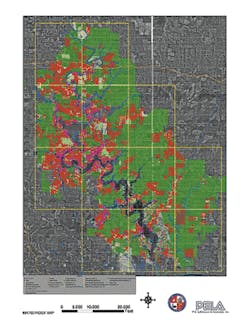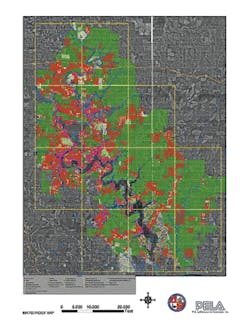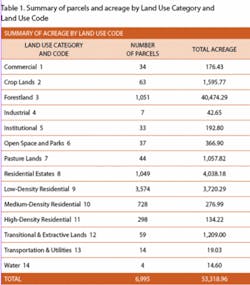by Lois D. George and Maurice Sledge
Lake Tuscaloosa, completed in 1970 by constructing a dam across North River, is the reservoir for the city of Tuscaloosa's drinking water supply and is also a significant public recreation center. This water supply source provides water to the city's expanding customer base and the 12 area water authorities served by the city. Lake Tuscaloosa consists of 5,885 acres with a full pool capacity of 40 billion gallons of water. The water drawn from the lake is treated and meets or exceeds the national standards for public health.
The North River watershed, comprising Lake Tuscaloosa, Lake Nicol and Lake Harris, is one of the city's most important natural resources. Protection of the watershed, including the city-owned property that surrounds it, is one of the city's highest priorities. During the last decade, the geographic area adjacent to these invaluable water resources has experienced explosive growth and development and the infrastructure that serves this area has also been modified accordingly.
Working with P.E. LaMoreaux & Associates, Inc. (PELA), the city recently completed a detailed land use assessment of about 85 square miles of the watershed. The assessment was presented as a concise, straightforward, management tool with two components: 1) a series of baseline maps that illustrate current land use and databases of supporting information; 2) a brief report with specific recommendations for future implementation. Together they serve as a baseline of existing conditions at the time of the study; a guideline for new watershed-wide policies that will encourage orderly development while preserving this unique and critical natural resource; and a framework for presentation of educational programs and outreach.
Land Use Categories
Land use and land cover are inherent characteristics within any watershed. A watershed is a dynamic system influenced by climatological conditions and anthropogenic changes. Land use distribution and extent within a watershed affect the quality of water and the availability of groundwater and surface water.
Detailed land use data are necessary to evaluate impacts. For this assessment, land use categories were determined after review of prior investigations and in consultation with personnel in the Water and Sewer Department. They provide consistency with past studies and continuity for the future.
A series of photo-maps (12 sheets — Sheet A through Sheet L) were prepared to illustrate, by color and Land Use Code, the Land Use Category of each parcel within the Study Area (see Fig. 1). Each of the 12 sheets is provided at a scale of 1 inch to 1,000 feet, and in digital format. The parcel-by-parcel land use is presented on each sheet by Color and Land Use (number) Codes.
Land Use Interpretation
The interpretation of land use was completed on a parcel-by-parcel basis. Fifteen specific land use categories were utilized and a category was assigned to each of the nearly 7,000 parcels evaluated (see Table 1). The coded land use category for each parcel was entered into the GIS geodatabase.
In addition to land use, other databases including the extent of city sewer service, septic tank registration, permitted piers, permitted boathouses, marina fuel tanks, utility right-of-ways, the city's raw water lines, and water-quality sampling locations have been included in the geodatabase. The specifics of the water-quality data and lake bathymetric information are also being built into the geodatabase.
The initial land use assessment was determined visually for each parcel from interpretation of low-level black and white aerial photography plotted at a scale of 1 inch to 500 feet. The parcel boundaries were obtained, also in digital format, from the city as created by Tuscaloosa County. All interpretive end products have been designed for Geographical Information Systems (GIS) format.
Each parcel was assigned a Land Use Code based on an assessment of the predominant land use of each parcel. The appropriate Land Use Code was then written on the photographic plot, within the actual parcel boundary. A parcel of multiple uses (for example, both a residence and crop land) was assigned a single Land Use Code based on the predominant land use of the parcel.
Topographic mapping and knowledge of the area were used in conjunction with the visual assessment of the photography to distinguish as accurately as possible between certain types of developed parcels (institutional, commercial, residential). Also, if land was parceled and not consistent with the use interpreted from the photography, the appropriate residential code was assigned, based on the parcel sizes. In addition, where parcels were only partially within the watershed, only that area within the watershed was assessed in assigning the predominant Land Use Code.
Quality Control
The initial land use assessment was reviewed by the project Senior Scientist. Next, the Land Use Code for each parcel was entered into the GIS geodatabase. As a standard control measure, the first plot of the code was checked against the hand written data. As an additional control measure, subsequent plots also included the County land use code. The County codes were attached to the original parcel database provided to PELA. The County code descriptors were then checked by the project Senior Scientist with the project code assigned for consistency in the assessment of land uses. Finally, a windshield inspection of the developed areas along the major highways and streets was completed and Land Use Codes were verified, and modified if necessary.
Summary
The assessment and electronic documents are tools designed to be readily updated or modified for use in meetings with shareholders, community and state leaders, and regulators to express the concerns and vision of the city, to highlight the urgent need to understand and protect the watershed, and properly regulate growth and development adjacent to the lakes and within the watershed.
The databases are being updated and expanded on an on-going basis. The mapping, interpretation of mapping components, and the testing data are part of the city's ongoing efforts toward protection and preservation of Lake Tuscaloosa. These tools are being used to support implementation of city policies and ordinances relative to zoning, conservation, and land development, and the adoption of new policies and ordinances; educational outreach for the general public; monitoring and enforcement; and the basis for and development of supplemental testing programs and additional investigations.
Maintaining the integrity of the watershed at a quality acceptable for all users and uses is a top priority for the city. Lake Tuscaloosa has a large volume of water storage and, therefore, a large pollution attenuation ability. Impacts of pollutants in its watershed have been of less concern in the past. With time, however, the cumulative impacts of population growth and associated watershed development have reduced the capacity of the reservoirs and will cause continued degradation of water quality in the watershed. Only through concerted, proactive, disciplined management of these resources will the city be assured of the volume of water storage and level of water quality enjoyed today.
About the Authors:
Lois D. George, P.E., is vice president of LaMoreaux & Associates, Inc. (Tuscaloosa, AL). Maurice Sledge is the Water and Sewer Department Director for the city of Tuscaloosa.





